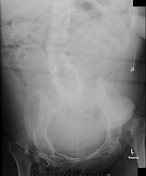47 results found
Article
Aicardi syndrome
Aicardi syndrome is a rare severe developmental disorder. It results from an X-linked genetic defect that is fatal in males and therefore only manifests in females (except for rare 47, XXY cases).
Terminology
Aicardi syndrome is distinct from Aicardi-Goutieres syndrome although both are named ...
Case
Bertolotti syndrome

Published
08 Feb 2024
94% complete
X-ray
Case
Bilateral clubfoot - congenital talipes equinovarus

Published
16 Aug 2023
82% complete
Ultrasound
Article
Butterfly vertebra
Butterfly vertebra, also sometimes known as a sagittal cleft vertebra or anterior rachischisis, is a type of vertebral anomaly that results from the failure of fusion of the lateral halves of the vertebral body because of persistent notochordal tissue between them.
Pathology
Butterfly vertebra...
Case
Charcot arthropathy of the knee

Published
28 Apr 2020
85% complete
X-ray
Article
Charcot joint
Charcot joint, also known as a neuropathic joint or Charcot (neuro/osteo)arthropathy, refers to a progressive degenerative/destructive joint disorder in patients with abnormal pain sensation and proprioception.
Epidemiology
In modern Western societies by far the most common cause of Charcot jo...
Article
Charcot joint causes (mnemonic)
The causes of a Charcot joint can be remembered, using a mnemonic - with a little poetic license - as they (all) start with the letter S.
Mnemonic
s: sugar (diabetes)
s: syphilis
s: steroid use
s: syringomyelia
s: spinal cord injury
s: spina bifida
s: scleroderma
s: scaly disease (lepro...
Article
Clasp-knife deformity
Clasp-knife deformity is relatively common congenital anomaly found at the lumbosacral junction.
Terminology
When a clasp-knife deformity is accompanied by pain on extension secondary to protrusion of the enlarged spinous process (knife blade) into the sacral spinal canal, it is called clasp-k...
Case
Clasp-knife syndrome

Published
16 Jun 2015
75% complete
X-ray
Article
Congenital diaphragmatic hernia
Congenital diaphragmatic herniation (CDH) accounts for a small proportion of all diaphragmatic herniae. However, it is one of the most common non-cardiac fetal intrathoracic anomalies.
Epidemiology
Congenital diaphragmatic hernias are seen in 1 of every 2000-4000 live births. 84% are left-side...
Article
Congenital talipes equinovarus
Congenital talipes equinovarus is considered the most common anomaly affecting the feet diagnosed on antenatal ultrasound.
Terminology
While some use talipes equinovarus and clubfoot synonymously, in certain publications, the term clubfoot is considered a more general descriptive term that des...
Article
Developmental dysplasia of the hip
Developmental dysplasia of the hip (DDH), or in older texts congenital dislocation of the hip (CDH), denotes aberrant development of the hip joint and results from an abnormal relationship of the femoral head to the acetabulum.
Unlike congenital dislocation of the hip, developmental dysplasia o...
Case
Diastematomyelia type I

Published
26 May 2023
92% complete
MRI
Case
Hip dislocation and spina bifida

Published
21 Mar 2018
91% complete
X-ray
Case
Jarcho-Levin syndrome

Published
18 Jan 2018
91% complete
Ultrasound
X-ray
Article
Klippel-Feil syndrome
Klippel-Feil syndrome is a complex heterogeneous entity that results in cervical vertebral fusion. Two or more non-segmented cervical vertebrae are usually sufficient for diagnosis.
Epidemiology
There is a recognized female predilection 1. Klippel-Feil syndrome has an incidence of 1:40,000-42,...
Case
Klippel-Feil syndrome with sprengel deformity

Published
21 Apr 2017
92% complete
X-ray
CT
Case
L5/S1 spondylolisthesis secondary to spondylolysis

Published
18 Mar 2018
93% complete
X-ray
CT
Article
Pes cavus
Pes cavus, also known as talipes cavus, refers to a descriptive term for a type of foot deformity with an abnormally high longitudinal arch of the foot (caved-in foot).
Epidemiology
Associations
It is often associated with certain neuromuscular disorders such as:
Charcot-Marie-Tooth disease:...
Article
Posterior vertebral fusion anomalies
Posterior vertebral fusion anomalies are relatively common and should not be mistaken for fractures. They are thought to be both developmental and pathological (e.g. spondylolysis) but are typically asymptomatic and incidental, and considered as anatomical variants. There are six types of poster...









 Unable to process the form. Check for errors and try again.
Unable to process the form. Check for errors and try again.